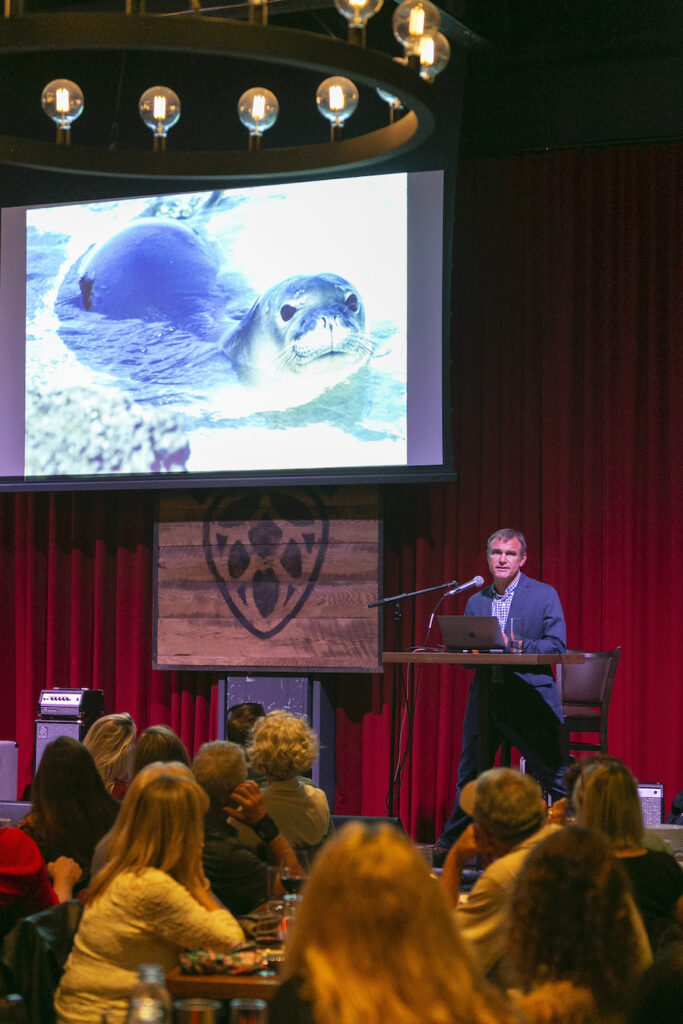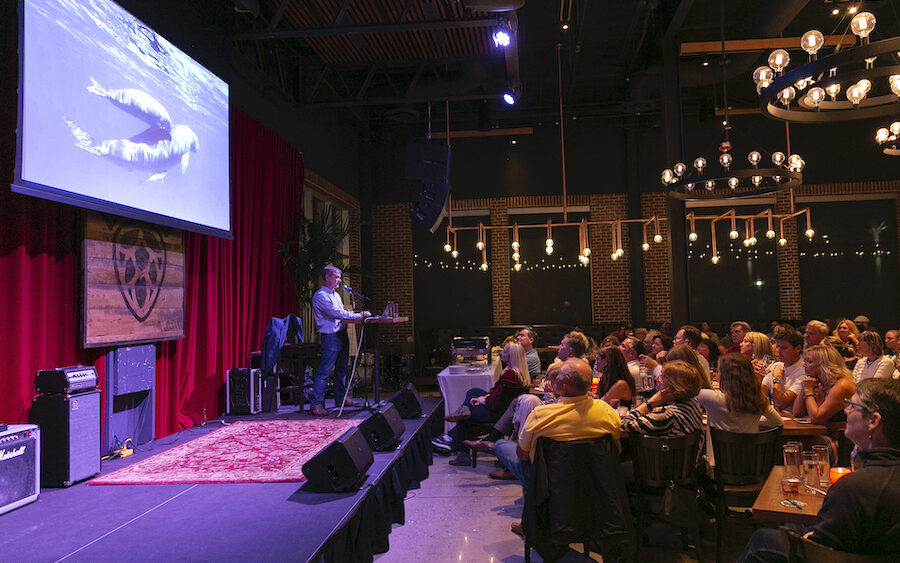After a short journey to Daniel Island, guests filled Dockery’s and were ready for an adventure. We welcomed Scott Snider, a renowned natural history filmmaker whose work takes him around the world as an accomplished, underwater long lens and macro cinematographer. Snider is also the South Carolina Aquarium Education Programs Committee Board Chair and plays an integral role in the the Aquarium’s Reef Research Project.
Snider’s work supports understanding and conservation of the natural world. Early in his career, he worked with the distinguished Crittercam Team. This research effort outfitted animals, including the endangered Hawaiian monk seal, with special camera technology. At the time, efforts were underway to harvest the black coral reef surrounding the northern Hawaiian Islands. Scientists had no proof that this was an important feeding ground for the endangered monk seal. That is, until the cameras were deployed! All five deployments showed that this was an extremely important hunting ground. This information was enough to halt the destructive fishery.
Snider’s footage provides insight into animal life history both abroad and in our backyard. Attendees held their breath as he showed American alligator footage from a local barrier island. One television program that Snider worked on showed how animals at the top of the food chain can push the limits of their abilities. American alligators, caught on film, found a way to hunt in saline environments. Alligators are believed to stick close to freshwater since they don’t have salt-filtering glands. Not far from here, they use their large, muscular tails to create gator wallows that fill with rainwater. After a few days of hunting in salty waters, they make a long journey back to these freshwater retreats for a long soak.
A place of nightmares for some, China’s Snake Island is home to 20,000 pit vipers. Snider and his team watched many snakes eat birds that were stopping over on their long migration. The difficult part was filming a snake catching a bird. Long days were spent putting their efforts into one individual at a time, and it finally paid off. Snider focused on a pit viper resting on a thin branch blowing in the wind. The second a bird touched down on the branch, the viper sprung into action.
A Lowcountry animal has developed an equally impressive way to capture its next meal. Bottlenose dolphins corral fish and hydroplane onto the sandy banks. The fish, now trapped on the sand, bounce back to the water’s edge and right into the dolphin’s mouth. Guests watched this process in vivid, slow motion. This method of feeding, called strand feeding, is a learned behavior passed down from one dolphin to the next. “One dolphin thought it was a good idea and told the others,” Snider laughed.
Snider never ceases to be amazed by the resilience of animals. On a recent trip to the post-apocalyptic Chernobyl zone in the Ukraine, he documented a thriving wolf population. There is no hunting or poaching occurring in this zone due to the amount of radioactive material. With no humans, boar and bison populations have exploded and now support over 300 predatory wolves. To compare, the wolf population in Yellowstone is 70.
Much like the Chernobyl site, if given protections, life can rebound. Locally, man-made structures have become important habitats for fish. Some habitats have permits for extra protection, such as fishing restrictions. Marine Protected Areas (MPAs) keep species safe by helping them grow with minimal threats. Over time, the MPAs become overcrowded and fish will flow into unprotected waters. This is known as “spillover.” When spillover occurs, the entire food web benefits.
Snider reflects, “We’re bloody, covered in ticks and exhausted from the day. We’ll say, ‘we’re never going back there again,’ but then we rest and eat something and look at the breathtaking shots and find ourselves saying, ‘I can’t wait to get back out there!’” Whether it’s an awe-inspiring trip to the Galapagos to film 200-year-old giant tortoises, a quick glimpse of a dugong mother sheltering her calf or witnessing local American alligators carry their young to the water’s edge, Snider never tires of nature’s fortitude. “Pay attention to your backyard just like you pay attention to what’s happening internationally with wildlife,” encouraged Snider. Globally, he’s watched incredible places disappear. The Raspacul River in Belize is one of many examples. This lush flood zone valley, where tapirs and macaws once thrived, is unrecognizable today. “What’s happening here in our own backyard is just as important!” Snider concluded.
Thank you to our sponsors, Mary and Mason Holland and Dockery’s.
Excited for the next Holland Lifelong Learning lecture? View the list of upcoming sessions.


